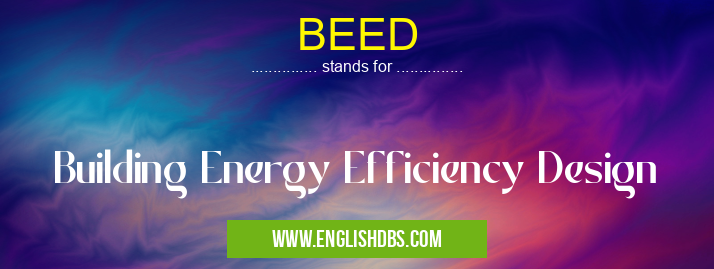What does BEED mean in ENERGY
BEED stands for Building Energy Efficiency Design. It is a comprehensive approach to designing buildings that minimize energy consumption while maximizing occupant comfort. BEED principles incorporate energy-efficient building materials, systems, and practices to reduce the building's environmental impact and operating costs.

BEED meaning in Energy in Governmental
BEED mostly used in an acronym Energy in Category Governmental that means Building Energy Efficiency Design
Shorthand: BEED,
Full Form: Building Energy Efficiency Design
For more information of "Building Energy Efficiency Design", see the section below.
» Governmental » Energy
BEED Meaning in GOVERNMENTAL
In the context of government regulations and policies, BEED refers to standards and guidelines that promote energy efficiency in buildings. Governments worldwide have implemented BEED initiatives to reduce greenhouse gas emissions, improve air quality, and promote sustainable building practices.
BEED Full Form
Building Energy Efficiency Design (BEED)
What Does BEED Stand for?
BEED encompasses various aspects of building design that contribute to energy efficiency, including:
- Building Envelope: Optimizing the building's exterior walls, roof, windows, and doors to minimize heat loss and gain.
- Lighting Systems: Utilizing energy-efficient lighting technologies, such as LEDs and daylighting, to reduce electricity consumption.
- Heating, Ventilation, and Air Conditioning (HVAC): Designing HVAC systems that are energy-efficient and maintain optimal indoor air quality.
- Renewable Energy: Incorporating renewable energy sources, such as solar panels and geothermal heat pumps, to supplement or replace conventional energy sources.
- Energy Monitoring and Control: Implementing systems that allow the building's energy consumption to be monitored and controlled in real-time to optimize efficiency.
Essential Questions and Answers on Building Energy Efficiency Design in "GOVERNMENTAL»ENERGY"
What is BEED?
Building Energy Efficiency Design (BEED) is a comprehensive approach to designing and constructing buildings that are highly energy-efficient. BEED involves a wide range of strategies and technologies to reduce energy consumption, including passive design, efficient building systems, and renewable energy sources.
What are the benefits of BEED?
BEED offers numerous benefits, including:
- Reduced energy costs: BEED buildings typically consume significantly less energy, lowering operational expenses and saving money.
- Improved occupant comfort: BEED buildings provide a more comfortable and healthy indoor environment with optimized temperature, air quality, and lighting.
- Environmental sustainability: BEED reduces carbon emissions and conserves natural resources, contributing to a more sustainable built environment.
- Enhanced property value: BEED buildings are often more attractive to tenants and buyers due to their lower energy bills and environmental credentials.
What are some key strategies in BEED?
BEED incorporates various strategies, such as:
- Passive design: Optimizing building orientation, window placement, and thermal insulation to maximize natural lighting and reduce heat loss.
- Efficient lighting: Using LED and other energy-efficient lighting fixtures, sensors, and controls to minimize lighting energy consumption.
- High-performance HVAC systems: Implementing energy-efficient heating, ventilation, and air conditioning systems with variable speed drives and smart controls.
- Renewable energy integration: Installing solar panels, wind turbines, or geothermal systems to generate on-site renewable energy and reduce grid dependence.
How is BEED implemented in practice?
BEED implementation typically involves the following steps:
- Energy modeling: Conducting detailed energy simulations to predict building energy performance and identify areas for optimization.
- Code compliance: Ensuring compliance with relevant building energy codes and standards, such as ASHRAE 90.1 in the United States.
- Design decision-making: Selecting appropriate materials, systems, and technologies based on energy-efficiency criteria.
- Construction oversight: Monitoring construction progress to verify the implementation of BEED measures.
- Post-occupancy evaluation: Measuring actual building energy performance and making adjustments as needed.
Are there any certifications or standards for BEED?
Yes, several certification and rating systems are available to evaluate and recognize BEED buildings, including:
- LEED (Leadership in Energy and Environmental Design)
- BREEAM (Building Research Establishment Environmental Assessment Method)
- WELL Building Standard
- Green Star
- Energy Star for Buildings
Final Words: BEED is a crucial approach to designing buildings that are energy-efficient, environmentally friendly, and cost-effective. By incorporating BEED principles into construction projects, architects, engineers, and contractors can contribute to a more sustainable and energy-conscious built environment. Governments play a vital role in promoting BEED through regulations, incentives, and education programs, ensuring that the benefits of energy efficiency are realized in the building sector.
BEED also stands for: |
|
| All stands for BEED |
